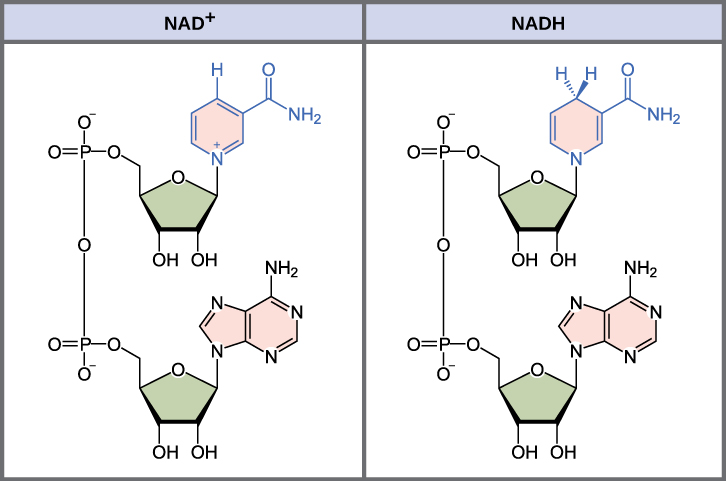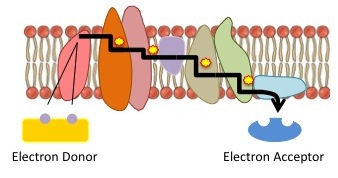| << Chapter < Page | Chapter >> Page > |
NAD + can accept electrons from an organic molecule according to the general equation:
When electrons are added to a compound, they are reduced. A compound that reduces another is called a reducing agent. In the above equation, RH is a reducing agent, and NAD + is reduced to NADH. When electrons are removed from compound, it oxidized. A compound that oxidizes another is called an oxidizing agent. In the above equation, NAD + is an oxidizing agent, and RH is oxidized to R.
Similarly, flavin adenine dinucleotide (FAD + ) is derived from vitamin B 2 , also called riboflavin. Its reduced form is FADH 2 . A second variation of NAD, NADP, contains an extra phosphate group. Both NAD + and FAD + are extensively used in energy extraction from sugars, and NADP plays an important role in anabolic reactions and photosynthesis.

The energy associated with high energy electrons is harvested in an incremental fashion, and electron transport chains allow for this type of energy harvesting. An
Electron Transport Chain is a series of membrane bound proteins that are specialized in shuttling electrons (
[link] ). An electron donor drops off high energy electrons and as the electrons pass from one protein to the next in the chain, a small amount of energy is released. The energy release by each step is then available to do work. After the electrons pass through the transport chain, the electrons are removed from the chain and attached to the final electron acceptor. As you will see later in this module, electron transport chains play an important role in the processes of photosynthesis and cellular respiration.

A living cell cannot store significant amounts of free energy. Excess free energy would result in an increase of heat in the cell, which would result in excessive thermal motion that could damage and then destroy the cell. Rather, a cell must be able to handle that energy in a way that enables the cell to store energy safely and release it for use only as needed. Living cells accomplish this by using the compound adenosine triphosphate (ATP). ATP is often called the “energy currency” of the cell, and, like currency, this versatile compound can be used to fill any energy need of the cell. How? It functions similarly to a rechargeable battery.
When ATP is broken down, usually by the removal of its terminal phosphate group, energy is released. The energy is used to do work by the cell, usually by the released phosphate binding to another molecule, activating it. For example, in the mechanical work of muscle contraction, ATP supplies the energy to move the contractile muscle proteins. Recall the active transport work of the sodium-potassium pump in cell membranes. ATP alters the structure of the integral protein that functions as the pump, changing its affinity for sodium and potassium. In this way, the cell performs work, pumping ions against their electrochemical gradients.

Notification Switch
Would you like to follow the 'Principles of biology' conversation and receive update notifications?